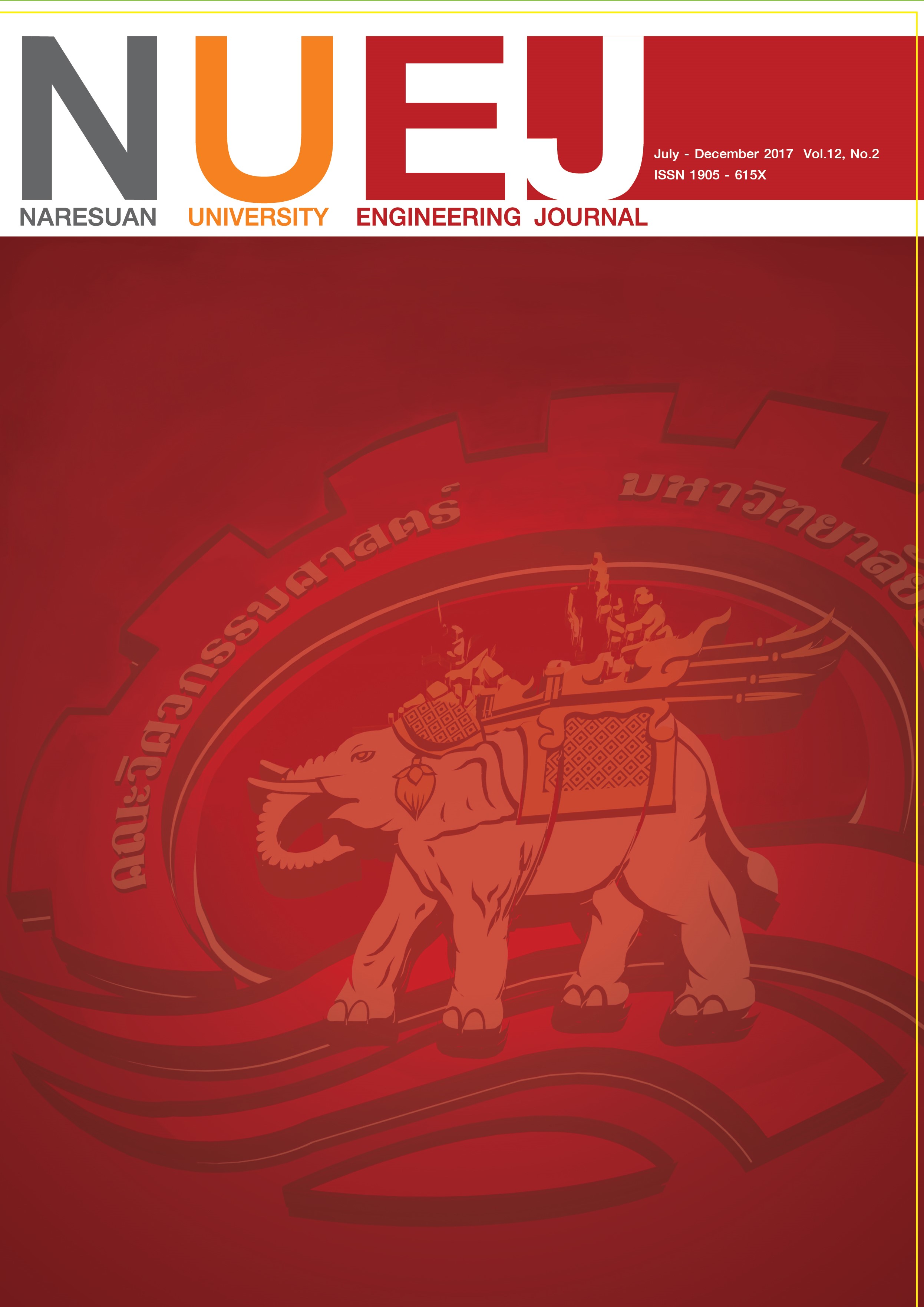The Effects of Magnetic Fields on Viscosity, Color and pH of Longan Honey
Main Article Content
Abstract
The magnetic fields were introduced in substitution of high temperature and prolonged heating during honey production with a promise of improved flowability and appearance of longan honey. The honey samples were exposed to magnetic fields of the permanent magnets for six hours at room temperature. The study was divided into two sets of magnetic fields depending on the maximum fields measured at the ends of the rod magnets. The lower magnetic fields were at 1400 G and 1600 G (samples F01 and F02), and the stronger magnetic fields at 4300 G (samples N01 and N02). The magnetically treated honey samples were then determined for any change of viscosity, color, pH, moisture content and total soluble solids (TSS) content. It was found that the honey samples subjected to the strong magnetic fields of 4300 G reduced their apparent viscosities from 6.7 Pa·s (control) to 6.1 Pa·s. The viscosity flow curves of all honey samples tested at the shear rates of 0.13 to 25 s-1 presented Newtonian behavior. The color space of all honey samples subjected to the magnetic fields showed increases in L* (from 26.43 to 29.59) and a* (from 3.12 to 5.22) values but decreases in b* values (from 12.09 to 11.12). As the result, color of the treated honey became lighter, more red and slightly yellow. In addition, the positive potential of hydrogen ions (pH) analysis showed that the honey samples became more acidic with stronger magnetic fields, and their pH values decreased from 4.23 (control) to 4.14, 4.16, 3.82, and 3.84 for the samples subjected to magnetic fields of 1400 G and 1600 G (F01, F02) and 4300 G (N01, N02), respectively. Moisture and TSS contents of all samples were, however, unaffected by the magnetic fields.
Article Details
References
[2] Agricultural Research Development Agency (public organization). (2016). Longan planting area economic strains in Thailand. Retrieved from http://www.arda.or.th /kasetinfo/logan/index.php?option=com_content&view=article&id=313%3A2010-12-08-08-14-20&catid=15%3A0 15 &Itemid=8.
[3] Agricultural Technology Promotion Center (Economic Insects) Chumphon Province. More to come: Honey is good. (2016). Retrieved from http://www.Aopdb 03.doae. go.th/KM/best%20 bee.html.
[4] The Roztocze Beekeepers Association, Poland. (1988). Polish Honey Standard: Physico-Chemical Require-ments (PN-88/A-77626). Retrieved form http://www.rzp.pl /certyfikat_ jakosci_miodu.pdf.
[5] Juszczak, L. and Fortuna, T. (2006). Rheology of selected Polish honeys. Journal of Food Engineering, 75, 43-49.
[6] Munro, J.A. (1943). The viscosity and thixotropy of honey. Journal of Economic Entomology, 36(5), 769-777.
[7] National Honey Board. (2017). pH and acids in honey. Retrieved from http://www.honey.com/images/downloads /refguide.pdf.
[8] Apoussidis, E. and Wells, I. (2004). Magnets. In: Edwards, M. ed. Detecting foreign bodies in food. Cambridge: Woodhead Publishing Limited, pp. 63-85.
[9] Craig, J.P. (2004). Metal detection. In: Edwards, M. ed. Detecting foreign bodies in food. Cambridge: Woodhead Publishing Limited, pp. 47-62.
[10] Vshivkov, S.A., Rusinova, E.V., Kudrevatykh, N.V., Galyas, A.G., Alekseeva, M.S. and Kuznetsov, D.K. (2006). Phase transitions of hydroxypropylcellulose liquid-crystalline solutions in magnetic field. Polymer Science, 48(10), 1115–1119.
[11] Baker, J.S. and Judd, S.J. (1996). Magnetic amelioration of scale formation. Water Research, 30, 247-260.
[12] Hołysz, L., Chibowski, M. and Chibowski, E. (2002). Time-dependent changes of zeta potential and other parameters of in situ calcium carbonate due to magnetic field treatment. Colloids and Surfaces A, 208, 231-240.
[13] Dobersek, D. and Goricanec, D. (2014). An experimentally evaluated magnetic device's efficiency for water-scale reduction on electric heaters. Energy, 77, 271-278.
[14] Mahmoud, B., Yosra, M. and Nadia, A. (2016). Effects of magnetic treatment on scaling power of hard waters. Separation and Purification Technology, 171, 88-92.
[15] Tombácz, E., Ma, C., Busch, K.W. and Busch, M.A. (1991). Effects of a weak magnetic field on hematite sol in stationary and flowing systems. Colloid and Polymer Science, 269, 278-289.
[16] Morimitsu, M., Shiomi, K. and Matsunaga, M. (2000). Magnetic effects on alkylammonium chloride solutions investigated by interfacial tension measurements at the mercury/solution interface. Journal of Colloid and Interface Science, 229(2), 641-643.
[17] Hatamie, A., Parhama, H., Zargar, B. and Heidari, Z. (2016). Evaluating magnetic nano-ferrofluid as a novel coagulant for surface water treatment. Journal of Molecular Liquids, 291, 694-702.
[18] Simeonidis, K., Kaprara, E., Samaras, T., Angelakeris, M.,Pliatsikas, N., Vourlias, G., Mitrakas, M. and Andritsos, N. (2015). Optimizing magnetic nano-particles for drinking water technology: The case of Cr(VI). Science of the Total Environment, 535, 61–68.
[19] Pina, A.S., Batalha, I.L., Fernandes, C.S.M., Aoki, M.A.and Roque, A.C.A. (2014). Exploring the potential of magnetic antimicrobial agents for water disinfection. Water Research, 66, 160-168.
[20] Hosoda, H., Mori, H., Sogoshi, N., Nagasawa, A. and Nakabayashi, S. (2004). Refractive indices of water and aqueous electrolyte solutions under high magnetic fields. Journal of Physical Chemistry. A, 2004, 108(9), 1461-1464.
[21] Xiao-Feng, P. and Bo, D. (2008). The changes of macro-scopic features and microscopic structures of water under influence of magnetic fields. Physica B, 403, 3571-3557.
[22] AOAC. (2006). Official Method of Analysis: Proximate Analysis and Calculations (Moisture Method 934.01). 17th ed., Association of Analytical Communities, Gaithersburg, MD.
[23] Bureau of Technology for Teaching and Learning Office of the Basic Education Commission Ministry of Education. (2016). Electric and Magnetic. Retrieved from http://www.cpn1.go.th/media/thonburi/lesson15_Electric MagneticI/content7.html.
[24] Sopade, P.A., Halley, P., D’Arcy, B., Doebler, C. and Caffin, N. (2002). Application of the Williams-Landel-Ferry model to the viscosity temperature relationship of Australian honeys. Journal of Food Engineering, 56, 67-75.
[25] Junzheng, P. and Changying, J. (1998). General rheological model for natural honeys in China. Journal of Food Engineering, 36, 165-168.
[26] Tepić, A.N., Šumić, Z.M. and Vukan, M.B. (2010). Influence of particle diameter on the colour of ground pepper (Capsicum annuum L.). APTEFF, 41, 1-203. doi: 10.2298/APT1041087T.
[27] Nunta, R. and Intipunya, P. (2013). Melting of crystallized sunflower honey by high power ultrasonic method. Food and Applied Bioscience Journal, 1(1), 24-33.


